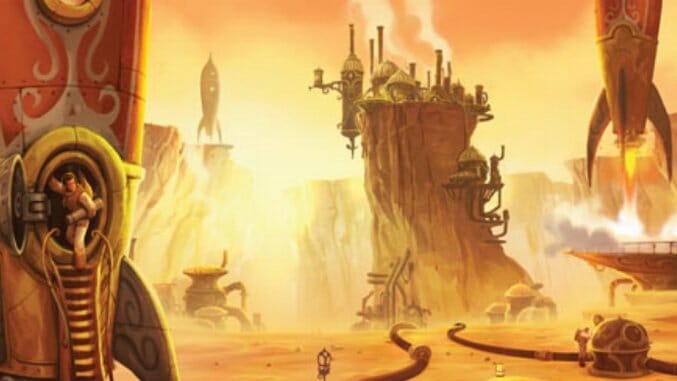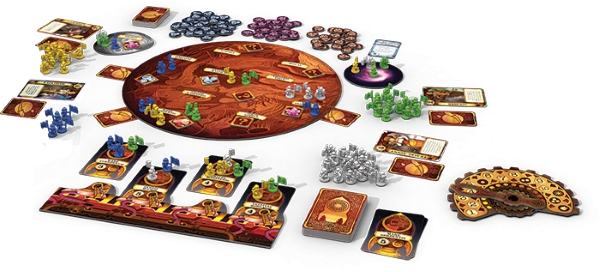
The brand new edition of Fantasy Flight Games’ Mission: Red Planet maintains the same core rules as the 2005 original. This time, however, the board game features updated components and several new tweaks, plus new opportunities for players to score more points. And while the 2005 original was for 3-5 players, the second edition has been expanded to allow for as many as six players—or for as few players as two.
Mission: Red Planet is set in a steampunk retrofuture, where the players are Victorian-era space explorers racing to colonize and mine Mars. (The “steampunk” aspect is almost comically irrelevant here; it’s an area-control game with a space-exploration theme, period.) It’s a solid, light family-strategy game that moves very quickly, with rules that are brief and easy to grasp even for younger competitors.
To start, there are spaceships available to all players, docked at the game’s single base, with the number of ships equal to the number of players. The players then take turns placing their astronauts on the ships, launching the ships, getting their little men on Mars, and moving them around the board, trying to obtain control of more areas, gaining points either from the planet’s resources, or by meeting criteria on individual “Mission” cards.
The game uses the player roles mechanic found in later games like Concordia. Each player plays from a deck of nine role cards, choosing one role secretly each turn; roles come up for play based on their number, starting from 9 and counting down to 1. Players may not reuse a role until they play role 9, the Recruiter, after which they restore their role deck to its original nine.
These various roles allow players to place astronauts on one or more ships, to sabotage other players by forcing their ships to launch early (they otherwise launch when full of astronauts, with capacities ranging from 2 to 6), to alter the destination of a ship to a different region of Mars, or to kill an opponent’s astronaut and replace him with the player’s own.
The winning strategy is simple and straightforward: You’re trying to get your little guys on Mars and move them around to control as many regions as you can. This involves lots of backstabbing as you try to gain or regain control, either in time for a “production phase” or for game-end scoring.
During any of the game’s production phases (there are three in all), players earn coins for the resources produced by the areas they control—which is to say, if you have the most astronauts in a region, you get the resource coins for that region for that phase. (The game divides Mars into eight regions, where each region’s resources might be worth anywhere between 1 and 3 points, so strategy is of the essence.)

Each player also begins the game with a Mission card that rewards game-end bonuses for meeting certain challenges and criteria. End-game scoring also includes any Discovery cards players have played, face-down, under the game board, which can alter scoring for certain regions or criteria, as well as additional Mission cards the players may have acquired along the way.
There’s also a Global Mission card awarding nine points to the player with the most ice (the resource with value 1) point tokens at game-end. Each player adds up the value of resource tokens, secret missions completed, and any additional bonuses, with the highest scorer named the winner. (In a three-person game, we’d have a winner as high as the 70s.)
This new edition also includes four Action cards. These are one-time-use cards that a player can play right before the final scoring, shaking the game up. Players might deploy an Action card to move a few astronauts around on Mars, or possibly even to restore some dead astronauts from the “Lost in Space memorial” (that is, the “discard” pile) back to life on the planet.
The new edition looks great, although the deck of Mission, Discovery, and Action cards is needlessly small. The inclusion of just four Action cards, and the sheer scarcity of those cards within game play—you have to play the Scientist role to get one, and in a ten-round game, you’re not using any role more than three times at most—can skew final scoring quite a bit.
We also found the explanation of what to do with resource tokens when no player has the most astronauts on a specific region to be lacking (it turns out you leave the coins in the region for someone to try to claim in the next production phase).
Despite all the tweaks made to the 2015 edition of Mission: Red Planet, the number of ways to score points still feels limited. This, in turn, limits the number of strategies. So game-play doesn’t vary much on repeat plays, maybe even becoming somewhat rote—you occupy regions, you get resources, you complete missions, maybe hit a bonus or two.
But the game is also very balanced with a high degree of interaction, and the pace is swift. Three-person games took us under an hour, and my daughter (age 9) had no trouble understanding the rules, scoring, or what was necessary to score more points.
Ultimately, Mission: Red Planet is a great choice for family game night—just as long as none of the players is young enough to try to eat the astronauts.
Mission: Red Planet was designed by Bruno Faidutti and Bruno Cathala, and published by Fantasy Flight Games. Originally published in 2005, the updated Second Edition was released last month.
Keith Law is a senior baseball writer for ESPN.com and an analyst on ESPN’s Baseball Tonight. He also covers games, literature, and more, at his personal blog “the dish.”